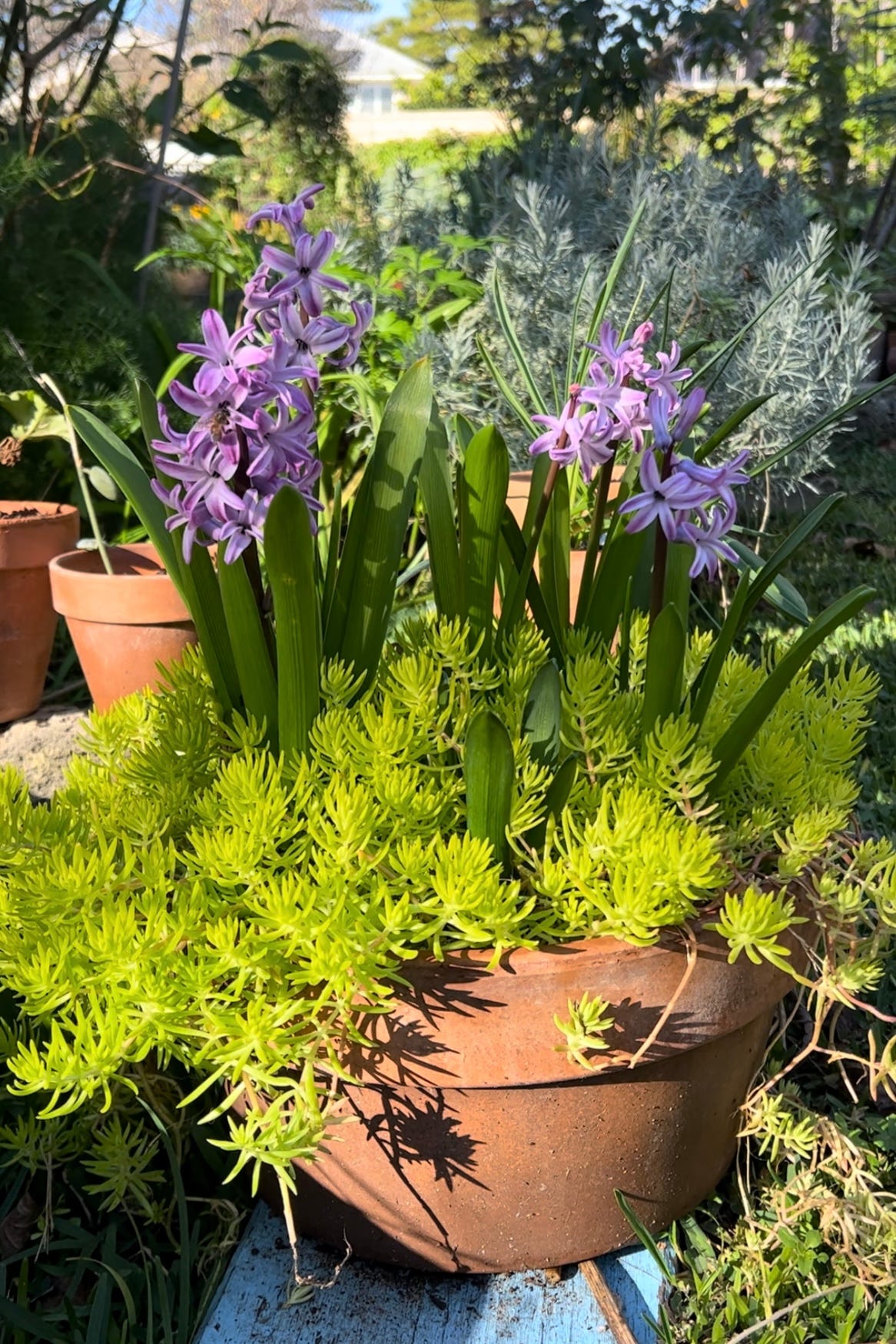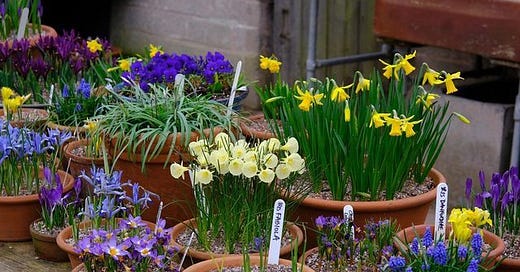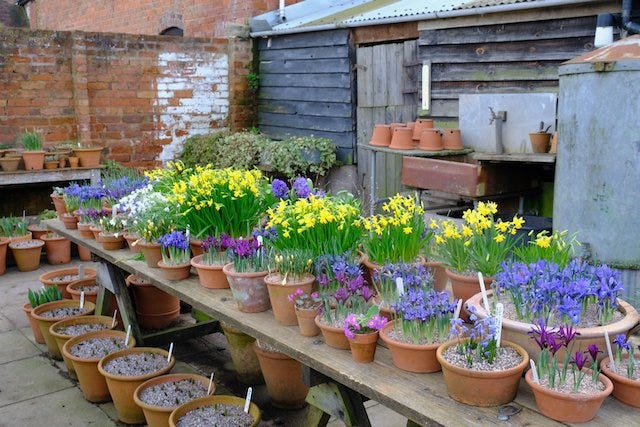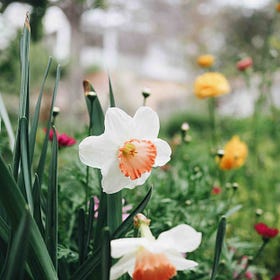This is a letter about self-delusion and spring bulbs.
I speak to so many gardeners who dream of a particular sort of garden. One bordered by rolling, grassy meadows, filled with lush and rambling plants (foxgloves! delphiniums! hydrangeas! peonies!), populated by ducks, rabbits, foxes, and watered effortlessly by rain that pours willingly from the sky all year round.
An English garden. That is an English garden.
Well my dry and dusty friends, we do not have English gardens (except, of course, for those of you who actually do live in England, and send me beautiful, jealousy-inducing messages containing words like ‘bramble’, ‘heavy clay soil’ and ‘allotment’). We have Australian gardens. And for about half the year the brutal conditions we have to contend with in our gardens are impossible to ignore. That is, until autumn arrives.
Autumn presents the Australian gardener with a glorious opportunity for months of self-delusion. The temperature drops, the rain comes (if we’re lucky), there are chill mornings and the sun, when it’s out feels milder, kinder and far less brutal.
Welcome to the part of the year when we can pour ourselves generous cups of tea, roast potatoes and pretend we have British gardens.
The thing is (and I say this a lot), there’s no reason why you can’t grow a garden in the English cottage garden style, even if you live in a place like Perth. The style is totally replicable in Australia, even if some of our plant choices have to change. Here are two of my favourite past posts about growing a cottage garden in Australia.
How to grow an English cottage garden
The English cottage garden; romantic, rambling, floral and wild. Pastel blooms intermingling with fragrant herbs and leafy vegetables. Roses climbing up archways. Blossoms falling from crabapple trees in the soft breeze while some sexually frustrated Jane Austin dame in a high-necked dress and uncomfortable boots pulls potatoes from the ground wishing she had voting rights and didn’t have to cook dinner or marry the town’s only weirdo bachelor.
Grow this, not that: the cottage garden edition
The whole reason so many of us think we can’t grow cottage gardens in WA is because we’re focusing on a handful of highly specific, namby pamby, wishy washy little wussy plants that can’t hack it in our backyards. And all we really need to do is sub these needy plants out for their similar-but-tougher, badass cousins that are just as beautiful and don’t mind the (parched, desolate) conditions we have to offer them.
So you see, it can be done. It can even be fun. But today we don’t need to worry about any of that. Today we are staring down the barrel of 6 months of cool, quiet, wintry weather, and that means we don’t have to use any fancy tactics at all, we can just pretend we are English and do as the English do. And that means I am planting a potted spring bulb table, and I really think you should too.
Monty Don’s potted spring bulbs
Monty’s bulb table is generous but also restrained. He uses a limited palette of colours (yellow, white, purple) and he almost always has only one kind of bulb in each pot. I think these tactics are so much wiser than attempting a hodgepodge or ‘bulb lasagne’, where you cram a heap of different bulbs into a single pot in the hopes that they’ll flower one after the other without crowding each other out. That has never worked for me and, in my opinion, it’s a bit of a gimmick.
Although his bulb choices are limited and organised, inside every pot Monty is generous - the pots overflow with blooms - and the way they are so organised and categorised reminds me of a kind of botanical garden show room.
He also plants a lot of miniature bulbs, which look very beautiful in small pots.
My spring bulb table
Here are the bulbs going into my own potted spring bulb display this year:
Daffodils:
Mini tete boucle (miniature daffodils that grow to only 15-20cm tall. I bought 6 bulbs)
Mini tete a tete (another miniature daffodil growing 15-20cm tall, not very different to the mini set boucle…I just got overexcited. I bought 6 bulbs)
Hoop petticoat (these grow to only 10cm and have blooms that remind me of Victorian bonnets or hoop dresses. I bought 15 bulbs)
Shirley Anne (unlike the other daffodils, which are all a bright butter yellow, Shirley Anne has large white petals with an apricot centre. It grows 40-50cm tall, so I will put it in one of my bigger pots. I bought 3 bulbs… probably not enough!)
Grape Hyacinths:
Grape hyacinths are gorgeous miniature flowering bulbs, which actually aren’t in the hyacinth family at all. Their flowers look like bunches of violet, bell-shaped grapes and they grow only 10-15cm tall. I bought 20 bulbs.
Freesias:
Freesias are easy to grow and can be left in your garden beds year after year, although mine almost never grow straight, but tumble over and I am too lazy to remember to stake them. This year I’ll see if they do better in a pot. I bought 30 bulbs of the Royal Blue variety, which comes in a beautiful blue-mauve.
Other bulbs to try (and not try)
At this point I decided to reign in my bulb-buying because, I must admit, I already have a lot of bulbs popping their heads out of pots, and until they flower I will have no clue what they are. If you are looking for another lovely purple bulb for your potted bulb table, Triteleia (spring stars) are gorgeous (they come in purple and white). Dutch irises would also be wonderful, as would Jonquils (their fragrance!) and Spanish bluebells.
I’m not growing hyacinths or tulips because I find they are fussier, more prone to bug attack and tulips almost never look good two years running (hyacinths can be so-so, but I usually find them disappointing).
If you want to grab some bulbs locally, they are currently in stock at Dawson’s garden world and Guildford garden centre, and I’ve noticed bulk packs of daffodils in Bunnings too. If you want to order online (where you can buy a wider range of more interesting varieties), try Tesselaar, Garden Express, WA bulbs (my favourite as it’s local), or the Diggers club. Some varieties (often Alliums) won’t be allowed into WA, but you can usually get most daffodils and other spring bulbs easily enough.

The hardest part about creating a spring bulb table is deciding which bulbs to buy. The rest is easy. I plant my bulbs closer than they recommend on the packets, so that the pots look nice and full. For large bulbs, I nestle them in together so they are almost touching. Smaller bulbs I will space with a few cm in between each bulb. Check the instructions on the packet to see how deep to sow each bulb, and make sure to plant your bulbs the right way up (there are usually pictures on the packets to show you which way is up). That’s about it!
A few more tips
Use a good quality potting mix (don’t skimp on this, as the quality of the potting mix you use will determine how well your bulbs grow). Make sure your pots have good drainage holes so the soil can’t get waterlogged, and then place them in a sunny position and, while you wait for the winter rains, give them a squirt with the hose every few days so the soil doesn’t dry out.

If you have planted all of your bulbs and find the look of a potting table filled with nothing but seemingly empty pots full of soil (it will take a while before the shoots emerge), you can plant violas or pansies on top of the bulbs. This works especially well for the larger bulbs, as the violas and pansies don’t compete for space. For smaller bulbs (miniatures, grape hyacinths, Triteleias and the like), it’s better to leave the pot alone to do its thing. Your bulbs will shoot before too long, and, as the clouds gather and the nights grow long and dark, they will be a lovely little beacon of hope for warmer days ahead.
For more information on growing spring bulbs, here are two other posts I’ve written:
An ode to spring bulbs
In just one week, autumn will be upon us. The beginning of autumn is like an amazing first date you once had at the start of what eventually becomes a totally disappointing relationship. It starts so well. Everything is new and exciting and beautiful - there’s a frisson in the air and you think ‘ ‘Yes! yes! This is for me. This is wonderful. This is
Spring bulbs part II: the good, the bad, the ugly
It’s been approximately two weeks since I wrote a newsletter about spring bulbs. In the intervening time, I have received a box of impulsively ordered bulbs (containing 50 dutch irises, 50 sparaxis, 100 ixias and 100 ranunculi) and I have decided that I have more to say. The first of which is that if ‘ixias’, ‘sparaxis’ and ‘ranunculi’ sound like words from a foreign language: read on, because
Thank you for reading! See you next time for more Lo fi life!
If you’d like to access all my garden guides and the full archive of recipes and posts, you can upgrade to a paid membership by clicking the button below.
And if you enjoyed this newsletter, please feel free to share it with your friends!










I’m so glad to have found your substack. I have failed with gardens for years and I am determined to have a thriving garden! Can you reccomend some swoon worthy but realistic English garden accounts please? Like your but for the UK!? X
I saw another Australian grower who grew cold weather crops in your winter (I recognised them as UK early spring to early summer crops) like carrots and other roots, peas, broadbeans, sprouting broccolis. Could they work in your region? I get jealous of seeing what crops you can grow through your winter as it feels like we have so much less due to the minus temps we get and we had night time ones right up into first half of March.